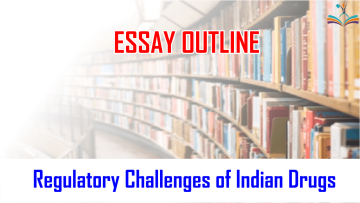
Here is an essay outline for the topic “Regulatory Challenges of Indian Drugs”:
Introduction
- Introduction to the topic
- Importance of the Indian pharmaceutical industry
- Regulatory challenges of Indian drugs
Body
- Challenges with drug regulation in India
- Lack of resources and infrastructure
- Inadequate staffing
- Outdated regulations
- Corruption
- Impact of regulatory challenges on the Indian pharmaceutical industry
- Low quality drugs
- Counterfeit drugs
- Lack of transparency
- Increased risk of patient harm
- Ways to address regulatory challenges in India
- Increased funding for drug regulation
- Increased staffing of regulatory agencies
- Reform of drug regulations
- Increased transparency
Conclusion
- Summary of the main points
- Recommendations for addressing regulatory challenges in India
Additional Notes
- This is just a basic outline, and you may need to add or remove sections depending on the specific requirements of your essay.
- You should also do your own research to gather more information about regulatory challenges in India.
- Be sure to cite your sources in your essay.
Here are some specific examples of regulatory challenges that could be discussed in the essay:
Challenges with drug regulation in India
- Lack of resources and infrastructure: The Indian government does not have sufficient funding to adequately regulate the pharmaceutical industry. This means that regulatory agencies are often understaffed and lack the necessary resources to carry out their duties effectively.
- Inadequate staffing: Regulatory agencies in India are often understaffed, which means that they are unable to adequately monitor the pharmaceutical industry. This can lead to the production and distribution of low-quality or counterfeit drugs.
- Outdated regulations: The drug regulations in India are outdated and do not adequately reflect the latest scientific and technological advances. This can make it difficult for regulatory agencies to ensure the safety and efficacy of drugs.
- Corruption: Corruption is a major problem in India, and it can also affect the pharmaceutical industry. Regulatory officials may be bribed to approve drugs that do not meet safety or efficacy standards.
Impact of regulatory challenges on the Indian pharmaceutical industry
- Low quality drugs: The lack of regulation in India has led to the production and distribution of low-quality drugs. These drugs can be ineffective or even harmful to patients.
- Counterfeit drugs: Counterfeit drugs are also a major problem in India. These drugs are often produced in illegal laboratories and do not contain the active ingredients that they claim to have.
- Lack of transparency: The lack of transparency in the Indian pharmaceutical industry makes it difficult for patients to know what they are getting when they take a drug. This can lead to serious health consequences.
- Increased risk of patient harm: The regulatory challenges in India have led to an increased risk of patient harm. Patients who take low-quality or counterfeit drugs may experience serious side effects or even death.
Ways to address regulatory challenges in India
- Increased funding for drug regulation: The Indian government needs to increase funding for drug regulation. This will allow regulatory agencies to hire more staff and acquire the necessary resources to carry out their duties effectively.
- Increased staffing of regulatory agencies: Regulatory agencies in India need to be adequately staffed. This will allow them to monitor the pharmaceutical industry more effectively and prevent the production and distribution of low-quality or counterfeit drugs.
- Reform of drug regulations: The drug regulations in India need to be reformed. This will ensure that they are up-to-date and reflect the latest scientific and technological advances.
- Increased transparency: The Indian pharmaceutical industry needs to be more transparent. This will allow patients to know what they are getting when they take a drug and reduce the risk of patient harm.




